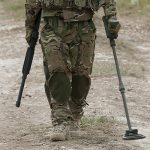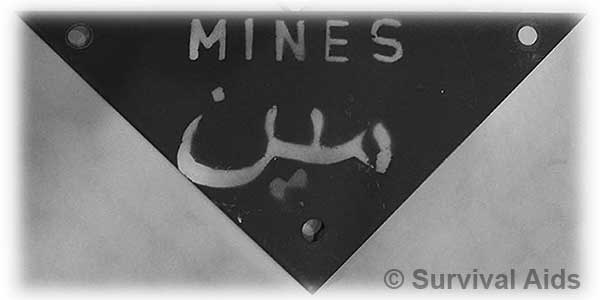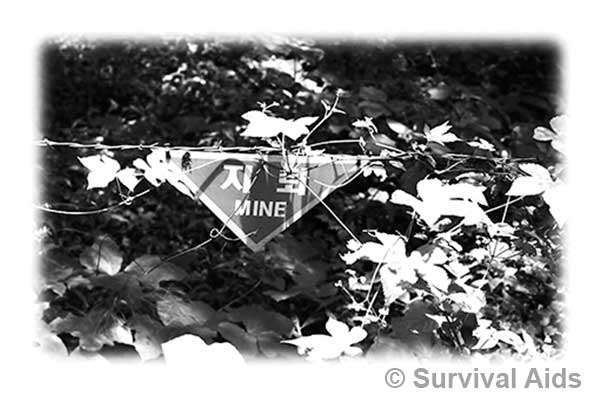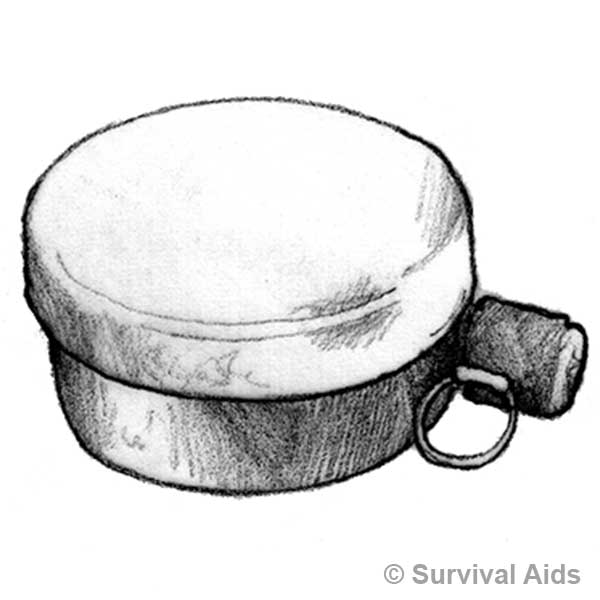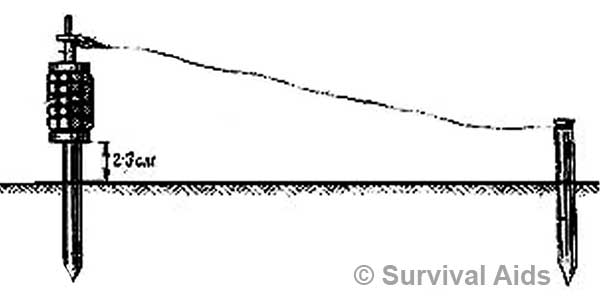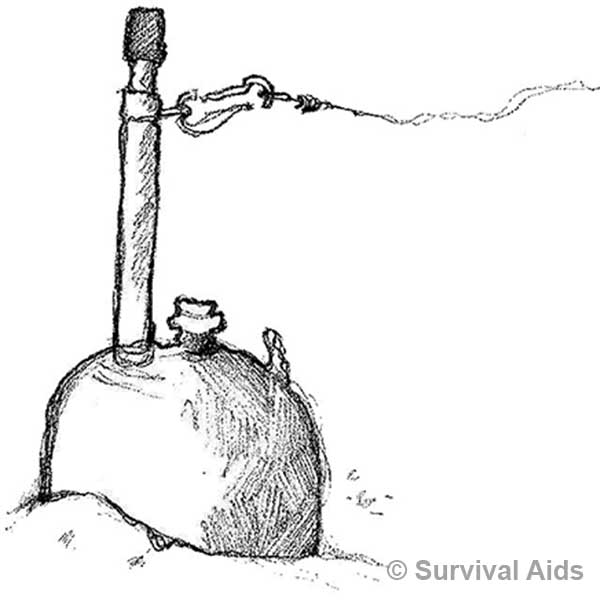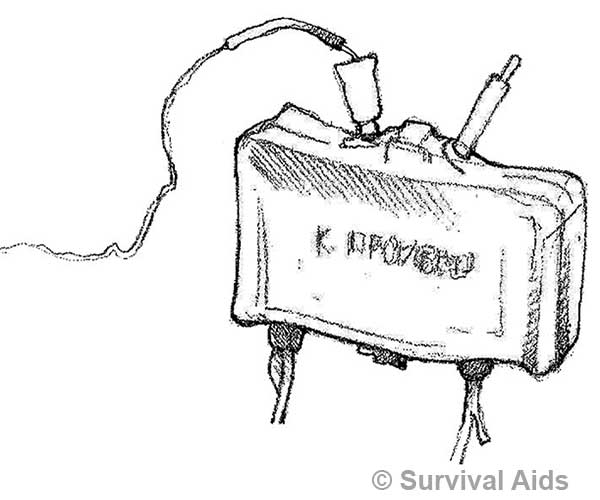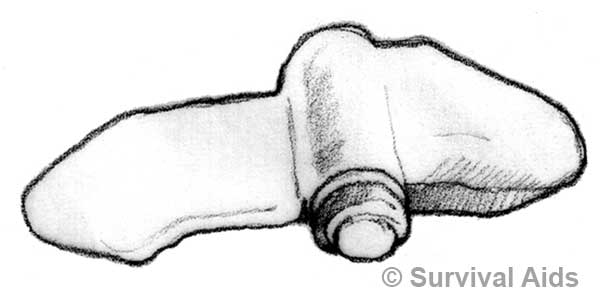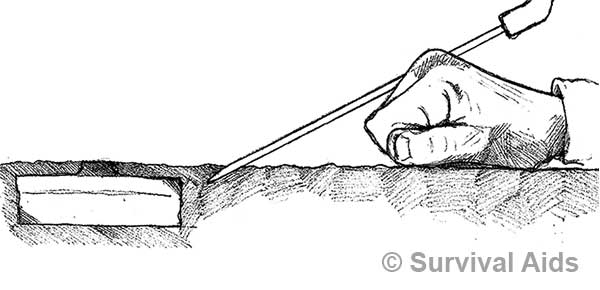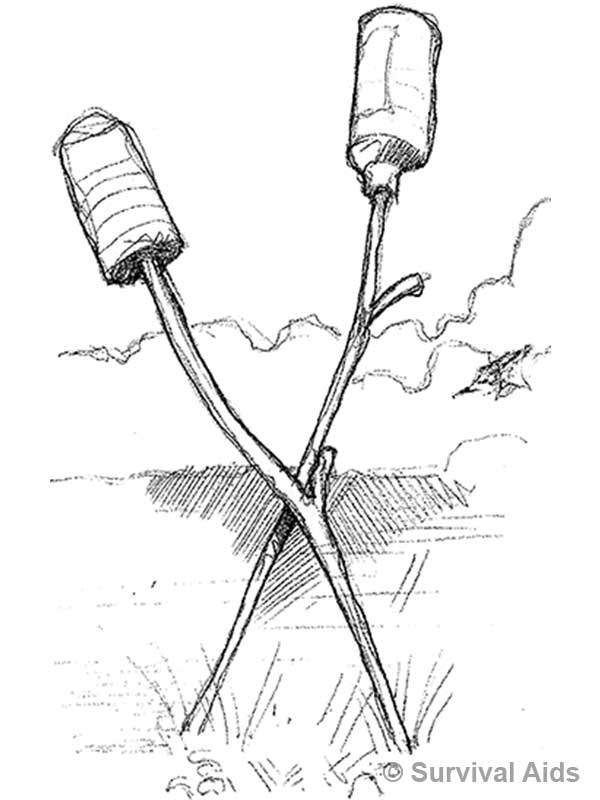Mines and Booby Traps - a deadly threat to British soldiers
Explosives and mines have long been a deadly threat to British soldiers, from car bombs and improvised grenades and rockets used by the Provisional IRA in Northern Ireland, to the recent tactics used by the Taliban.
For the foreseeable future mines and IEDs will be an obstacle and a threat to deal with, the enemy uses these weapons because they know they can’t defeat us in conventional combat.
Mines Sign
It is not the aim of this chapter to make you an expert in mine-clearing, all we can do is find them, make sure no one else steps on them, and alert ATO. Your PDT or OPTAG Trg will go into the detail of the current threats in theatre and teach you the current SOP.
WHY MINES?
Mines were designed to delay advancing troops, protect flanks and likely approach areas, to disrupt and channel formations into killing zones, the unseen lurking threat of mines is a potent fear inducer, and has a detrimental effect on morale. Mines don’t need feeding, don’t need to be relieved, they will cover your flank when you are asleep, but they are indiscriminate, they kill and injure both the enemy and you, as well as women, kids and livestock.
Mines are also used to protect flanks as part of a defensive position and to create a nuisance obstacle to delay troops. Minefields might be covered by machine gun or sniper fire, when the enemy have you static then you can bet they’ll press home their advantage. Other types of minefield might be a “dummy one” where there aren’t any mines just the surface signs, the enemy will know about it but you won’t, this might be a marked escape route for the enemy.
Mine Photo Grey
LEGACY MUNITIONS
Many of the areas that are today littered with mines are from conflicts long since over, the armies departed when they were laid they should have been clearly marked on maps and charts. They either were not marked at all or were lost and became just as much of a threat to those that laid them, as to their enemy and to the civilian population that had to return and work the land when the fighting moved on. They are referred to as Legacy munitions, and there are millions of them, at the present painstaking rate of clearing it will take almost a hundred years to be rid of them.
MINE TYPES
Mines fall broadly into two categories Anti-Personnel (AP) which are about the size of a tin of tuna or a tin of beans, designed to maim and injure rather than kill, although they often do. Antitank/vehicle (AT) to destroy/immobilise tanks and APCs, there are too many types and variants of mine to list in this book, so we have listed an example of a few types to give you an idea how they function.
Much of the damage, done to the lower limbs from AP mines, is from the blast itself with additional injury from the metallic casing, and from the debris that the blast pics up and turns into whirling shrapnel, stones, soil, nuts, bolts, glass.
The devastating power of an explosive is in the speed at which the plasticine like material, which might be for example the size of an orange, is transformed almost instantly into a cloud of gas the size of a warehouse, carrying everything with it.
Explosive - 12-3AP mine
There are a number of different types of anti-personnel blast, fragmentation, directional and bounding.
A typical off the shelf blast mine is a small plastic (non-metal construction nowadays to defeat metal detection) mine like the PMN, which once laid in position will have the firing pin removed and a small acid pellet which will eat through a retaining spring which will arm the mine allowing the layer to get clear. Foot pressure will initiate it and the blast will tear through the lower limb usually requiring amputation. These mines if not recovered, or destroyed can lay for years waiting for an unlucky victim, they commonly move about as soil moves, can be washed down slopes, into rivers, and even tilled by tractors etc...
Once laid they are all but impossible to defuse or make safe.
A FRAGMENTATION MINE
The POMZ-2 is a stake mounted, anti-personnel fragmentation mine, an explosive charge wrapped into metal casing or container (that resembles a bar of chocolate) designed to fracture and whip out as deadly shrapnel when the device functions. On a stake stuck in the ground at about knee height in cover, a tripwire will run across the track or path. The body of the mine is a cast-iron thick-walled tube with six rows of cast fragmentation “chunks”. The body of the mine is usually painted olive green. The wooden stakes may be green, brown or unpainted.
MINE POMZ2
BOUNDING FRAGMENTATION OZM-4
a metallic bounding fragmentation mine, they can be command or tripwire detonated, usually are found with a trip or trailing wire, which is just a loose wire that will get caught and pulled setting off the mine. Abounding fragmentation mine will usually kill the person who sets it off and injure anybody nearby by propelling fragments. The cylindrical mine body is located in a short pot or barrel, buried in the ground. Tripping the wire detonates a smaller explosive charge in the base of the pot, which propels the mine body upwards. As it “bounds” into the air, to the height of 0.5 a metre, the mine is activated by a thin cable secured to the barrel assembly. The cable pulls a pin from the bottom of the mine much like a grenade. The resulting blast scatters fragments, some of which may be performed, over a much wider radius if it had been on the ground, as it will be free of surrounding obstacles like bushes, grass etc...
Cylindrical Mine Body
DIRECTIONAL AP MINE MON-50
antipersonnel mine is a Soviet version of the American M-18 Claymore, a directional fragmentation mine. The curved plate is filled with ball bearings or short steel rods depending on the variant in front of the explosive charge.
It is usually sited backed against a tree or other hard surface to force the pellets forward into the designated killing area.
Directional AP Mine MON 50
Sometimes described as the military equivalent of the sawn-off shotgun, the widely copied American M-18 Claymore mine contains 700 steel balls and can kill targets up to 50 metres away. Other types can kill people as far away as 200 metres. Directional fragmentation mines can be victim initiated or by command wire.
PFM-1 “BUTTERFLY MINE”
These mines are responsible for high casualties among children, rumour had it that the mine was deliberately designed to attract children, in reality, the mine’s shape was dictated by aerodynamics, so that it could be deployed aerially both from helicopters and aircraft. Due to its unusual shape and colouring, green, grey and White, the mine was often mistaken for toys by children who would throw them in the air to watch them fly, or throw them at one another. Upon exploding it often resulted in hand and head trauma.
Butterfly Mine
Weight: 75 g Length: 120 mm Width: 20 mm
The mine is basically a plastic bag containing explosive liquid, squeezing the soft plastic skin of the mine forces the arming plunger to strike the detonator detonating the mine. The mine is stored with a pin restraining a detonating plunger. The arming pin is removed just before they are deployed, the plunger is slowly forced by a spring forward until it contacts the detonator, at which point it is armed.
AT MINES
An anti-tank mine is designed to damage or destroy vehicles, including tanks and AFV, a common tactic is to target the tracks so as to immobilise the vehicle, possibly as part of an ambush. Whenever an incident occurs always think of secondary devices. Compared to AP mines AT have a much larger explosive charge and a fuse designed only to be triggered by vehicles or, in some cases, tampering with the mine. However many old AT mines were housed in wooden cases, with time the wood has perished and disappeared entirely, the consequence of this is that the AT mine which used to have an initiating pressure of 300 kg, now has one as little as 5 or 6 kg, turning AT into a massive AP.
Modern developments in AT mines have seen different, more powerful explosive payloads, plastic being used in construction to make them harder to detect with metal detectors, shaped charges being employed that focus the power to penetrate the armour and sophisticated anti-tamper devices that target the EOD teams.
If you encounter a mine or minefield In a convoy that’s accidentally driven off the road, one vehicle has hit a mine, or you spot mine signs too late, or you’ve wandered off the road and suddenly you spot something in the grass!! What would you do? Always refer to OPTAG or your PDT, but here is a basic guide.
If you’re on foot, freeze and shout “STOP” and make sure everyone hears you, make sure the msg gets passed. You need to let everyone know and do it forcefully. Your objective is to make your way back very slowly to a metalled road or hard standing.
Do not be tempted to reverse out, using the tracks of the vehicle, you won’t be able to do it accurately enough to guarantee you won’t trigger it, and may have driven over a double impulse device which will function at the second pressure, these are designed to allow a patrol to pass over it and function when the rest of the ptl are well into the minefield.
LOOK, FEEL, PROD
The first step is to look at your feet, have a proper scan, you’re looking for things that shouldn’t be there, nature has very few straight lines, so look for straight edges of the casing, or the smooth curves, once you’ve identified it that’s it, leave it, mark it if you can, or if you can’t ensure that the guy behind you knows about it. Start clearing an area for your feet, ensure that it’s big enough for both feet and a bit of room to spare as well, because you’ll have to crouch down, so give yourself some wiggle room, and remember there’s no rush. It’s tiring and painstaking work, so make sure you clear enough room so that you can drop on your knee if you need to. When you’ve cleared it then you need to mark it, the best method is mine tape, but if you don’t have that then improvise, but ensure you mark it clearly.
Look Feel Prod
You’ll then start clearing your route back, via the shortest path possible. Carefully clear an area about the size of a cigarette packet or a pack of cards by sliding your prodder at 45 degrees over your knuckles, you go in from this angle to ensure you don’t prod the top of the mine and set it off. Clear one small area then clear around it in a similar way until you’ve cleared an area that you can squat in and put your knee down. In this fashion, you can clear a series of stepping stones of cleared ground back to a safe area.
WARNING SIGNS
Local people won’t have access to official signs, so they’ll improvise and you need to be aware of them. Painted rocks, red points to danger, white to a safe area, piles of stones, might mark dangerous areas. Indigenous signs, local people particularly in poor areas need the land, they graze their cattle and livestock on it, grow crops, they live there and will know from local knowledge and bitter experience where the danger areas are, you may well notice amputees in the area, children with a hand missing or scarring to the face, men on crutches.
Crossed warning signs sticks
ABSENCE OF THE NORMAL, PRESENCE OF THE ABNORMAL
All the things that you see combined together should alert you to the presence of danger, e.g. craters, dead livestock left out to rot in the fields, signs of damaged vehicles, scars of war, your J2 brief, or if non-military your background research. Crossed sticks with cans or bottles on them are a common local warning, lines of stones along a pathway, in fact, anything that looks like it’s been placed there for a reason, usually has been, so take care.
If in doubt don’t walk or drive off the metalled road (Tarmac) however if a track looks well used and you can see locals going up and down it then it might be ok, bear in mind though that due to some countries living with death/disfigurement and years of civil war they might behave a more “laissez-faire” attitude. But if a track is overgrown and not been used for a while, then it’s not worth the risk.
IMPROVISED EXPLOSIVE DEVICE
An IED is essentially an explosive device doing something other than what it was designed to do, for example, a 105 mm artillery shell concealed in a brick casing by the side of the road to ambush a convoy. Insurgents remove the explosive material from the vessel and press them into service in another form, they are resourceful and cunning and very good at what they do. In our armoury to counter these threats are our skilled, tireless, brave EOD men and women. Stay alert, switched on and vigilant, avoid setting patterns. Strong unit cohesion, sticking together when it goes wrong will see you through, both in theatre and in the months to follow.
Improvised Explosive Devices (IED) - are employed by insurgents, extremists and cranks. The term Improvised Explosive Device was first coined by the British Army in the 1970s, after the provisional Irish Republican Army (IRA) used bombs made from agricultural fertilizer and semtex to make highly effective boobytrap devices or remote-controlled bombs. An IED typically consists of an explosive charge (potentially assisted by a booster charge), a detonator, and an initiation system, which is a mechanism that initiates the electrical charge that sets off the device.
Antipersonnel IEDs typically also contain shrapnel such as nails or ball bearings (known as shipyard confetti after the metal waste found in the shipyards).
It is too large a topic to tackle in detail, we will illustrate a few of the dangerous devices that have been used in the past, it will give you some idea as to the ruthlessness cunning and ingenuity employed by the insurgents.
Be in no doubt they are very good at what they do and are constantly evolving their techniques if it doesn’t work they won’t use it, but if it does work and defeats our countermeasures and techniques it will spread.
SVBIED - Suicide Vehicle Bourne IED a car, van or bike laden with explosives, driven into the area of detonation, the bomber may well be a committed suicide bomber, and detonate himself and the bomb. However, a number of these devices have been found with “chicken switches” so that if the controller some distance back, thinks his bomber is going to bottle it, he will detonate it himself. These devices have recently been employed alongside assaulting groups who after the detonation at the gates of a compound, follow up with an assault (on fast-moving bikes, two gunmen to a motorbike) before making a quick getaway. Through careful observation, they know the response times of the QRF and can even lay obstacles in their path to delay them too.
VOIED - Victim Operated, or booby trap, could be initiated by using a pressure switch made up of two saw blades inside a compound at an obvious entry point for a search team. When stepped on the circuit will be completed and the device functions. These methods have also been used beneath items so that when they are picked up, a spring is released and the circuit is made.
RCIED - Radio Controlled IED can be detonated from a distance by a radio-controlled initiator such as a toy car controller. By altering the electronics inside it can be used to send an electrical current to the device which will function upon the arrival of the tgt. The explosive device can be put in place and when an opportunity target appears the bomber will strike and as has been seen they have no regard for civilian casualties.
CWIED - Command Wire IED, the bomber sits and waits for the vehicle to drive over it and detonates. Command wires are very hard to spot, so employing all your techniques and procedures at vulnerable points and likely choke points is essential. The further back a CW stretches the more power it needs to function, CW have been found stretching back 800 metres from the road.




